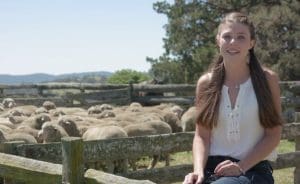Jade Moxey – BHP Billiton Science and Engineering Awards 2017 from CSIRO on Vimeo.
ASPIRING forensic scientist 16-year-old Jade Moxey has challenged current thinking on fireweed control options in her award-winning home farm research.
Jade’s project ‘Grazing sheep on deadly fireweed: A “BaaaaD” situation?’ has made her the 2017 student winner in the Investigations category of the BHP Billiton Science and Engineering Awards.
Fireweed is recognised as being toxic and potentially deadly to cattle, horses and pigs. It can also be toxic to humans, if the plant contaminates grain crops. However, sheep have a high tolerance to the potentially toxic pyrrolizidine alkaloids in the plant and until Jade’s research, the animals had been regarded by authorities as a simple, cheap and effective management method.
The Sapphire Coast Anglican College student from Bega in New South Wales has shown sheep can spread the noxious weed of national significance, while sustaining minimal health or tissue accumulation impacts. The weed is found along the south-eastern coast of Australia, is established along the entire New South Wales coast and has spread into Victoria and as far north as central Queensland.
Jade’s parents Darrell and Anne-Marie run a 300 hectare beef-sheep farm at Bega, NSW, producing Speckle Park and Limousin cross vealers from F1 mothers as well as a fine wool from their 18 micron Merino flock, utilising rotational grazing.
Click here to get the latest Sheep Central story links sent to your email inbox.
Fireweed germinated from sheep dung samples

Young science award winner Jade Moxey.
In her research, Jade germinated 213 fireweed plants from just two sheep manure samples.
“The fact that I found that sheep are capable of running viable fireweed (seed) through their manure while they are globally promoted as a successful method of control, challenges current agricultural practices that are being implemented, rotational grazing in particular.
“I think my research will alter current grazing management practices to ensure the successful control of fireweed,” Jade said.
She believed rotational grazing of sheep has helped spread fireweed on her parent’s farm and was motivated to undertake her research because the weed was spreading into non-infested areas after sheep were introduced.
“Fireweed was also most prolific where the sheep camped in concentrated numbers.
“I think that rotational grazing would be the worst of the alternate different grazing management practices, in that it allows the fireweed to regenerate once the sheep have consumed it,” she said.
“Practices such as set stocking wouldn’t allow for that to happen; however my research wasn’t looking particularly at grazing management practices, just the fact that they actually spread it in the first place.”
Jade sees a need for more research on how sheep could be used to help control fireweed, with her work indicating potential to better manage weed stands by not grazing seeding plants.
“The timing in which sheep were introduced to a fireweed-infested paddock would definitely have a lot to do with it, as would quarantining practices and also controlling sheep movement within a property to not allow sheep grazed on fireweed to enter a non-infested area.”
She has already implemented new fireweed control measures on the Bega farm, including not moving sheep from fireweed-infested paddock into a non-infested area.
“It is difficult since we do have cattle, in that set stocking isn’t very practical in the way that we manage our property, however; other less specific practices will definitely be implemented to try to control it.”
Jade said other herbicide control methods for fireweed have negative impacts and cultivation aided germination, but a root-eating flea beetle could be released in 2019 if research was successful.
“There is no particular method that is recommended to work, apart from using sheep, which I have now proven doesn’t actually work anyway,” Jade said.
Meat tested for alkaloids
Jade also studied whether the pyrrolizidine alkaloids entered the food chain via sheep meat. She conducted blood testing, liver analysis and liver histopathology to determine whether residual pyrrolizidine alkaloids were present in the tissue of sheep.
Jade found three of 12 meat tissue samples from sheep grazed on fireweed tested positive for the toxic alkaloids.
“However, the levels were well below safety recommendations and it was only very, very minute levels.”
The gas chromatography mas spectrometry testing revealed alkaloid levels of 0.0005 percent of Australian food standard’s safe daily intake and not a cause for concern.
Jade said she was very interested in animal research and agriculture.
“I am interested in forensics, which is entirely unrelated, but who knows where my research will lead me.”
Jade said her $4000 cash prize from the BHP Billiton awards will probably be banked to help meet future university costs. She also placed third overall in the 2016 Science Teachers Association of NSW Young Scientists Awards, winning the Earth and Environmental category and the STEP Environmental award. Jade will travel to the Intel International Science and Engineering Fair in Los Angeles in May this year. At the Wollongong Illawarra Coal Regional Science Fair she was first in the Year 10-12 age category.
NSW DPI info sheet recommends using sheep on fireweed

Flowering fireweed. Picture – NSW DPI.
According to NSW DPI’s Weedwise information sheet on fireweed, sheep and goats are more inclined to eat fireweed than cattle and are up to 20 times more tolerant of pyrrolizidine alkaloids. Merino sheep are more tolerant than British breeds or crossbred sheep because they restrict their daily intake of the plant whereas other breeds will eat it to excess. The DPI said if a group of sheep are forced to eat fireweed over two or more consecutive years then some of them may become affected and present with chronic ill-thrift or sudden death. Liver damage in sheep and goats does not usually result in nervous signs.
NSW DPI said sheep and goats preferentially graze fireweed and display a high tolerance to its poison, and “have proven to be a simple, cheap and effective management method”. However, to avoid stock health issues when fireweed is present, DPI recommends land managers should use a new group of animals each year and to limit the cumulative effects of fireweed poisoning not graze the same group on infested areas for more than two consecutive seasons. Do not use breeding stock for fireweed control. Either Merino or goat wethers are the ideal control group, not breeding stock, or, if this is not possible, British breeds or crossbred sheep, DPI said.
For more information on the 2017 BHP Billiton awards winners click here.
For more information on fireweed click here.



What an impressive young woman! Well done, Jade!